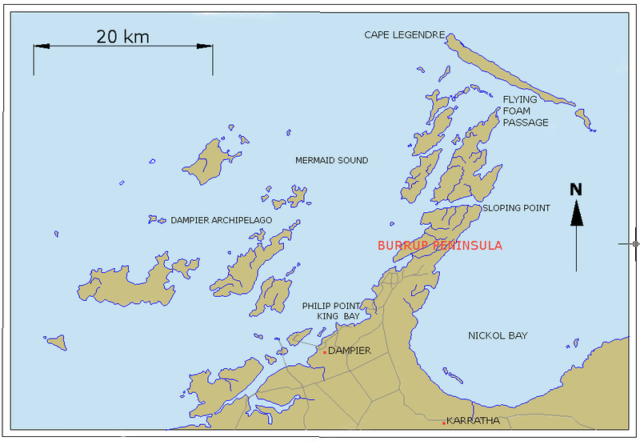Dampier Archipelago is a string of forty-two coastal islands in the Indian Ocean located off the Northwest coast of Australia among coral reefs, pristine beaches of white sand, and is home to the most biodiverse area of marine life in Australia. The islands, named after British explorer William Dampier, the first European to visit the islands in 1699, are a very popular destination for tourists and vacationers. It is believed that the islands were formed six to eight thousand years ago, when at the end of the last Ice Age rising sea levels flooded what was once a coastal plain. Twenty-five of the islands have been set aside as nature preserves to protect wildlife, and the area is being considered for National Park status. Scuba diving, snorkeling, boating, camping and fishing are just a few of the activities enjoyed by visitors. The islands are also home to several species of marine turtles and birds that use the beaches as breeding areas.

The islands are scattered with thousands of rock engravings created by the indigenous Aborigines, who consider the area a sacred place. The Ngarda-Ngarlie people believe ancestral beings created the islands during the Dreamtime, and that the spirits of Ngkurr, Bardi and Gardi remain in the area. The original inhabitants believe the blood of the spirits is responsible for the coloring of Marntawarrura, the black hills.
On Rosemary Island, one of the smaller islands open to the public, circular foundations created from stone have been discovered, leading archeologists to believe that the oldest settlers were living in dwellings built of stone. The knee-high foundations have been dated to about eight to nine thousand years ago. According to Professor Jo McDonald, director of the University of Western Australia’s Centre for Rock Art Research and Management, the rock structures would have had roofs made of animal skin or plants. “Excavations on Rosemary Island, one of the outer islands, have uncovered evidence of one of the earliest known domestic structures in Australia, dated between 8,000 and 9,000 years ago,” remarked McDonald. “This is an astounding find and has not only enormous scientific significance but will be of great benefit to Aboriginal communities in the area, enhancing their connections to their deep past and cultural heritage.”

The structures were divided into separate rooms for preparing food and for storage of shells left over from collected seafood. “The fact that people that long ago are thinking about how they can better deal with space… it certainly challenges most people’s idea of what a hunter-gatherer is,” McDonald remarked. The surrounding stones and boulders contain finely detailed engravings created by pounding, rubbing and scratching of the rocks and depict local plant life, marine life, mammals and spirit figures. Some may refer to sacred rituals and songs. Others depict everyday activities such as hunting and climbing as well as ritual ceremonies. Many depict now extinct species like the Thylacine, a carnivorous marsupial often referred to as the Tasmanian tiger. Rock structures also indicated locations of natural resources containing water holes. “We anticipate that this extraordinary rock art estate will produce some spectacular insights into what life was really like in deep history”, said McDonald.
The university archeologists are coordinating their efforts with the Murujuga Aboriginal Corporation and the local government and community in hopes that the site will qualify for a World Heritage listing. The groups are hoping to create a balance between the multi-billion dollar industry created due to the vast amount of natural gas, petroleum, and iron ore reserves found in the area making it the second largest tonnage port in the country and the rich historical significance and natural beauty of the coastal area.
